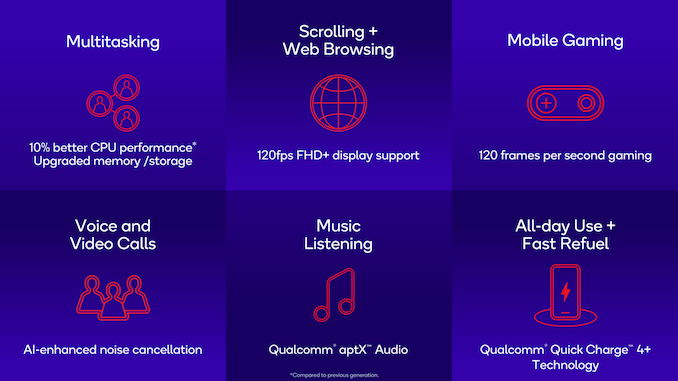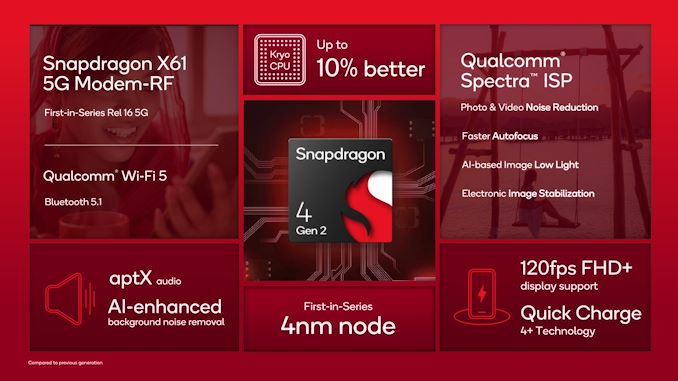Modest Modernization For Low-End Mobiles
Qualcomm this morning is taking the wraps off its subsequent period Snapdragon 4-class mobile SoC, the aptly named Snapdragon 4 Gen 2. The company’s new entry-level SoC for smartphones and completely different items incorporates some {{hardware}} updates that must modestly improve effectivity for basically probably the most cost-sensitive part of the mobile market, along with bringing Qualcomm’s whole Snapdragon product stack into nearer alignment by supporting extra moderen 5G necessities and fabbing the chip to a newer course of node.
At first, the best line on effectivity is that Qualcomm is touting a ten% improve in CPU effectivity, as a result of larger CPU core clockspeeds. The Snapdragon 4 Gen 2 makes use of the equivalent 2+6 CPU core configuration as its predecessor, the Snapdragon 4 Gen 1, with 2 Cortex-A78-derived Kryo CPU cores paired with 6 Cortex-A55-derived cores. As a consequence of a node shrink, Qualcomm has boosted the best clockspeeds on each set of cores by about 10%, bringing the A78 cores as a lot as 2.2GHz, and the A55 cores as a lot as 2.0GHz. So the ten% CPU effectivity obtain should be fairly fixed in every single and multi-threaded workloads.

Architecturally, there’s little to say about these cores that hasn’t been talked about already. These are pretty performant CPU cores, though the age and the dearth of higher clockspeeds means their effectivity potential is proscribed. The ultra-budget nature of the Snapdragon 4 assortment means this could be the ultimate part of Qualcomm’s stack to maneuver to any form of Armv9 core. Though curiously, the 4 Gen 2 does get somewhat little bit of a leg up over the 6 Gen 1 in relation to the A55 cores – 6G1’s small cores solely improve to 1.8GHz, no matter being fabbed on the equivalent course of node. So this will slim the CPU effectivity gap between these elements a bit (not lower than until the obligatory 6 Gen 2 lands).
Within the meantime, Qualcomm is staying mum on GPU effectivity. The company stopped giving their GPUs exterior product numbers just some years up to now, and for the Snapdragon 4 launch they are not even issuing effectivity expectations. So we aren’t anticipating any helpful properties proper right here, notably as a result of the chip continues to be meant to drive HD/FHD items.
| Qualcomm Snapdragon 4-Sequence SoCs | ||||||
| SoC | Snapdragon 4 Gen 2 (SM4450) |
Snapdragon 4 Gen 1 (SM4375) |
Snapdragon 480 (SM4350) |
|||
| CPU | 2x Cortex-A78 @ 2.2GHz 6x Cortex-A55 |
2x Cortex-A78 @ 2.0GHz 6x Cortex-A55 |
2x Cortex-A76 @ 2.0GHz 6x Cortex-A55 @ 1.8GHz |
|||
| GPU | Adreno | Adreno | Adreno 619 | |||
| DSP | N/A | Hexagon | Hexagon 686 | |||
| ISP/ Digital digicam |
Spectra (2x 12-bit) 1x 108MP or 32MP with ZSL |
Spectra (3x 12-bit) 1x 108MP or 32MP with ZSL |
Spectra 345 (3x 12-bit) 1x 64MP |
|||
| Encode/ Decode |
1080p60 H.264, H.265, VP9 (Decode-Solely) |
|||||
| Memory | 2x 16-bit @ 3200MHz LPDDR5 25.6GB/s or 2x 16-bit @ 2133MHz LPDDR4X 17.0GB/s |
2x 16-bit @ 2133MHz LPDDR4X 17.0GB/s |
2x 16-bit @ 2133MHz LPDDR4X 17.0GB/s |
|||
| Storage | UFS 3.1 (2 lane) | UFS 2.2, eMMC 5.1 | UFS 2.2, eMMC 5.1 | |||
| Constructed-in Modem | X61 Constructed-in (Rel. 16)
LTE 5G NO DL = 2500Mbps |
X51 Constructed-in (Rel. 15)
LTE 5G NO DL = 2500Mbps |
X51 Constructed-in (Rel. 15)
LTE 5G NO DL = 2500Mbps |
|||
| Wi-Fi/BT | Wi-Fi 5 (1×1) Bluetooth 5.1 |
Wi-Fi 5 (2×2) Bluetooth 5.2 |
Wi-Fi 5 (2×2) Bluetooth 5.1 |
|||
| Mfc. Course of | Samsung 4nm | TSMC 6nm | Samsung 8nm LPP | |||
As well-known earlier, Qualcomm has moved their entry-level SoC to a Samsung 4nm course of (given the timing, 4LPP, we’d assume). That signifies that Samsung’s full current product stack – Snapdragons 8G2, 7+G2, 6G1, and 4G2 – are all made on a 4nm node of some style. Samsung’s is the a lot much less performant of the two, nonetheless it’s just about really cheaper. Which is a boon for these entry-level, price-constrained elements. Academically, I’m curious merely how small the Snapdragon 4 die is based on this course of, appropriately pretty tiny, nonetheless that’s not a aspect Qualcomm normally shares.
In every other case, this latest Snapdragon 4-class SoC is somewhat little bit of a give-and-take launch as compared with the 4 Gen 1. On the memory side of points, the model new SoC incorporates Qualcomm’s newer controller design, bringing LPDDR5 assist to a 4-class chip for the first time. Like completely different Qualcomm SoCs, the chip can run that memory at as a lot as LPDDR5-6400 speeds. Within the meantime, LPDDR4X stays supported as correctly, on the bizarre LPDDR4X-4266 data cost. The memory bus continues to be a whole of 32-bits giant, so that you just’re a peak memory bandwidth of 25.6GB/second with LPDDR5, a full 50% additional bandwidth than what the 4 Gen 1 would possibly current.
The storage controller has moreover been updated to assist UFS 3.1, lastly bringing Qualcomm’s low-end chip as a lot as comparatively trendy mannequin of the flash storage commonplace. As compared with the UFS 2.2 spec supported inside the earlier chip, UFS 3.1 a bit larger than doubles the bandwidth per lane; so in a two-lane configuration, the 4G2 can theoretically swap as quite a bit as 2.9GB/second of information though Qualcomm isn’t making any effectivity claims. Notably, eMMC storage assistance is absent from Qualcomm’s specification sheet, indicating that assist for that now well-outdated interface commonplace is lastly utilizing off into the sunset.
As for Qualcomm’s imaging ISPs and related {{hardware}}, the 4 Gen 2 will possible be taking a step backwards by eradicating the third digital digicam pipeline. Consequently, 4 Gen 2 will solely assist as a lot as two cameras. The Spectra ISPs themselves are seemingly unchanged, with Qualcomm nonetheless using their 12-bit designs. On account of that digital digicam shift, the final imaging capabilities of the SoC have modified a bit, even in a two digital digicam configuration. The resolutions supported in twin digital digicam zero shutter lag mode are literally balanced; pretty than 25+13MPixels, the SoC runs at (as a lot as) 16+16Mpixels.
Though with fewer digital digicam modules to assist, Qualcomm is touting greater digital digicam effectivity. Significantly, Qualcomm says that the model new SoC provides faster autofocus assist than the 4 Gen 1, along with an updated digital image stabilization attribute. The 4 Gen 2 moreover consists of an “AI-enhanced” low mild attribute, and multi-camera temporal filtering (MCTF) assist has been baked into the SoC for noise low cost.
Substitute: And, speaking of AI points, as now we have since found following Qualcomm’s publication of the half’s product net web page, Qualcomm has moreover eradicated their venerable Hexagon DSP from this chip. The gathering of various acceleration blocks (particularly banks of SIMDs) is mostly used to successfully course of laptop imaginative and prescient, AI, audio, sensor fusion, and completely different duties. Counting on the workload, that’s each to ship extreme raw throughput, or inside the case of energy effectivity needs, course of a select class of duties much more successfully than on the CPU.
Hexagon has been a central part of Snapdragon SoCs as a result of the very first half over 15 years up to now, and whereas the diploma to which Qualcomm promotes it varies from period to period varies, it’s on a regular basis been there until now. Nevertheless with a focus on defending the related payment (and die measurement) of the Snapdragon 4 SoC down, Qualcomm has excised the DSP block and shifted its duties on to the CPU and the GPU. Lastly, this doesn’t affect the efficiency offered by the chip itself (software program program can on a regular basis run on the CPU, if the GPU is not going to do), nonetheless it means Qualcomm is drawing from a smaller assortment of a lot much less specialised {{hardware}} for data processing than it has been on earlier elements – which means they’re seemingly taking an effectivity hit inside the course of.
The final word major {{hardware}} change for the SoC, is an enhance to a Snapdragon X60-series class modem. New to Qualcomm’s product lineup is the Snapdragon X61 modem, a downscaled mannequin of their X62/X65 modem seem in numerous chips. Relative to the outgoing 4 Gen 1 SoC and its X51 modem, the X61 helps the newer Launch 16 mannequin (aka 5G Part 2) of the 3GPP commonplace family.
[image]
Launch 16 is now arising on 3 years earlier, so this generally is a needed change to take care of up with 5G neighborhood enchancment. Though because of the primary benefits of Launch 16 are additional for the neighborhood operations side than the client side, cellphone patrons don’t sometimes see quite a bit from it aside from some enhancements in safety. Throughout the case of the 4 Gen 2, the exact bandwidth figures are unchanged from the 4 Gen 1, which means downloads and uploads prime out at 2.5Gbps and 900Mbps respectively.
mmWave assist has moreover remained off of Qualcomm’s spec sheets this time spherical. On the 4 Gen 1 it ended up being an unlisted attribute of varieties – the {{hardware}} was there in case any handset vendor wanted to utilize it, nonetheless Qualcomm didn’t market it – and it’s unclear whether or not or not Qualcomm even bothered with the {{hardware}} for this new silicon.
Moreover of remember: Bluetooth 5.2 assist has disappeared from Qualcomm’s specs. Whereas the 4 Gen 1 supported BT 5.2, all through Qualcomm’s documentation 4 Gen 2 is listed as solely supporting BT 5.1. That’s notable not solely because of it’s a regression, nonetheless because of Bluetooth Low Energy Audio is a 5.2 attribute – and arguably the defining attribute of 5.2. At this degree it’s unclear why Qualcomm would want to take away the attribute from their low-end SoC (I suspected royalties, nonetheless the LC3 codec for LE Audio is part of the BT license).
The Wi-Fi half of Qualcomm’s radio system has moreover been downgraded compared with its predecessor. The 4 Gen 2 solely helps a single antenna (1×1), whereas earlier Snapdragon 4 elements have been 2×2. And although that’s new silicon, the easiest supported Wi-Fi commonplace continues to be Wi-Fi 5 (802.11ac), so the SoC hasn’t improved on what it could probably do with that single antenna. Suffice it to say, Qualcomm is betting far more carefully on cell connectivity than Wi-Fi for the form of rising and low-cost markets that Snapdragon 4 items are widespread in.

Wrapping points up, Qualcomm tells us that quite a few of the identical outdated suspects will possible be adopting the Snapdragon 4 Gen 2, along with Redmi and vivo. Handsets primarily based totally on the SoC are anticipated to be launched inside the second half of this yr.






